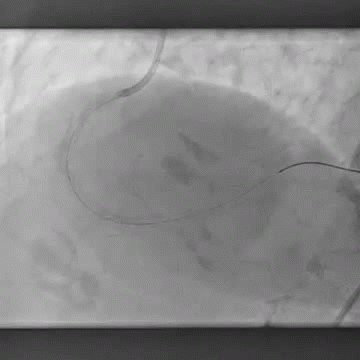Cardiac/Heart Diagnoses
Dr Robinson uses the full range of cardiac investigations to diagnose and manage heart disease. Below is an example of the diagnosis and treatment of a heart attack provided by Dr Robinson. The first video shows a blocked right coronary (heart) artery. The subsequent videos show Dr Robinson opening up the artery with stent insertion to restore normal flow in the coronary artery to provide treatment for the heart attack




Angina and Heart Attack
Angina and heart attacks are caused by furring up of the heart arteries which leads to narrowing and blockages in the heart arteries. This narrowing is due to a build up of atheroma (fatty deposits) in the wall of the artery. This blockage causes a symptom of chest, arm or neck tightness on exertion. If the narrowing becomes ‘unstable’ a blood clot can form on the narrowing which causes a complete blockage which leads on to a heart attack. This may also be called an acute coronary syndrome, coronary thrombosis or myocardial infarction. Angina and heart attacks may be diagnosed and treated with a coronary angiogram and stent insertion.
For more information visit the British Heart Foundation:

Atrial Fibrillation
Atrial Fibrillation (AF) is one of the commonest causes of an abnormal heart rhythm and a major cause of stroke. When present it may cause symptoms of palpitations, breathlessness and dizziness. In many cases however it is detected incidentally by ‘pulse checking’. Atrial fibrillation is increasingly common with age, present in 2% at 60, 5% at 70 and 10% at 80. It is particularly important as a risk factor for stroke. Detection of AF is important to then assess if blood thinning with Warfarin to reduce stroke risk is indicated. Atrial fibrillation may be controlled with medical therapy or treated invasively with ablation.
For more information visit the British Heart Foundation website

Heart Failure
Heart Failure is common and increases with age. Approximately 1% of people at 60 years and 10% of people at 80 years have heart failure. Causes of heart failure include past heart attacks, hypertension, heart valve disease, inherited cardiac abnormalities and excess alcohol. Heart failure may cause breathlessness, tiredness, weight gain or ankle swelling. Heart failure may be diagnosed with clinical examination, specialised blood tests (BNP) and investigations such as chest X-Ray, echocardiograms and CT scans. Treatment may involve lifestyle measures, medication or pacemakers which help coordinate the contraction of the heart (CRT or biventricular pacemakers).
For more information visit the British Heart Foundation

Hypercholesterolaemia
Cholesterol is produced in the body, mainly in the liver, and is an important part of cell membrane function, vitamin D and bile acid production. High levels of ‘bad cholesterol’ (LDL) are associated with an increased risk of coronary artery disease but increased levels of the ‘good cholesterol’ (HDL) are protective against coronary artery disease. If patients are detected to have a high cholesterol or LDL they will need careful risk assessment to determine if medical therapy with statins is indicated on top of lifestyle measures.
For more information visit the British Heart Foundation

Hypertension
Hypertension or high blood pressure is only detected when it is measured, usually with a blood pressure cuff. The blood pressure is measured with a ‘top’ figure (systolic pressure) and a lower figure (diastolic pressure). In normal circumstances the blood pressure should be on average below 145/85. Hypertension is a leading contributory factor to heart attacks and strokes. Raised blood pressure may run in families and genetic factors are often important. Hypertension may also be associated with being overweight, physical inactivity and consuming excess salt or alcohol. Once detected, hypertension is usually well treated with medication but Renal Artery Denervation is a promising therapy for ‘resistant hypertension’.
For more information visit the British Heart Foundation

Inherited Heart Disease and Cardiomyopathies
Dr Robinson does not see children with cardiac conditions. However, there are some conditions that we are born with which cause problems only in adult life. Important risk factors for coronary heart disease can be inherited including high cholesterol (hypercholesterolaemia) and a tendency to hypertension. Analysis of family history is important in risk assessment. The cardiomyopathies are a group of inherited disorders that affect the muscle of the heart. They include Hypertrophic Cardiomyopathy (HCM or HOCM), Dilated Cardiomyopathy (DCM) and Arryhthmogenic Right Ventricular Cardiomyopathy (ARVC). These conditions may be passed through families and so screening of family members with clinical examination, ECG and echocardiograms is important.
Valvular Heart Disease
The heart has four cardiac chambers and four cardiac valves. Disease of these valves may lead to narrowing or leaking (regurgitation) of the valve. Common causes of problems with the heart valves include being born with abnormal valves (congenital), rheumatic fever, enlargement of the heart, infection (endocarditis) and ageing. As the population is living longer disease of ageing heart valves is now seen more commonly. Symptoms may include those of heart failure (breathlessness and swelling of the ankles) but also chest pain, dizziness or even loss of consciousness. Valve disease is usually detected by clinical examination and then confirmed but echocardiogram. Treatment may be medical therapy but then also assessment for heart valve surgery if the valve disease is severe. Newer minimal access procedures such as TAVI (Transcatheter Aortic Valve Implantation) and Minimal Access Mitral Valve Surgery are now available.

